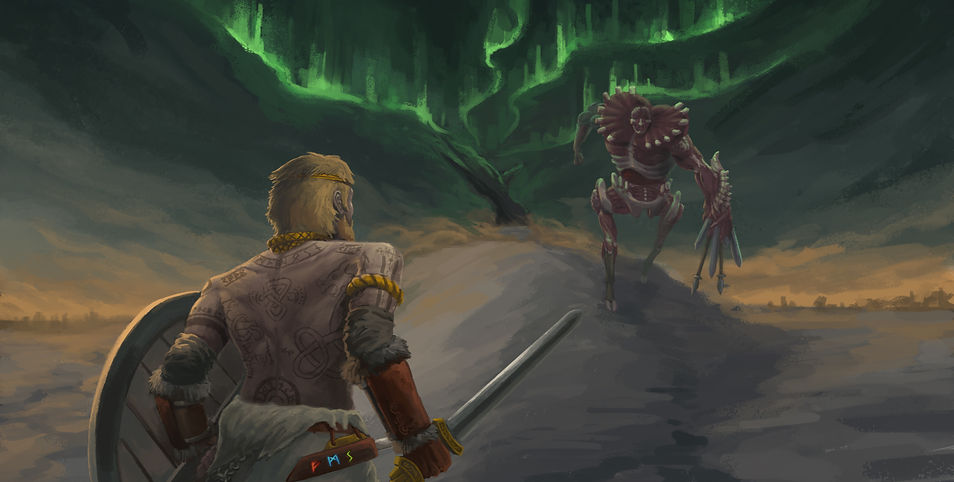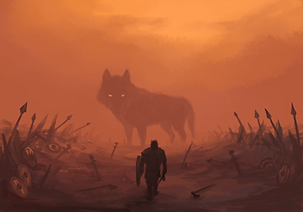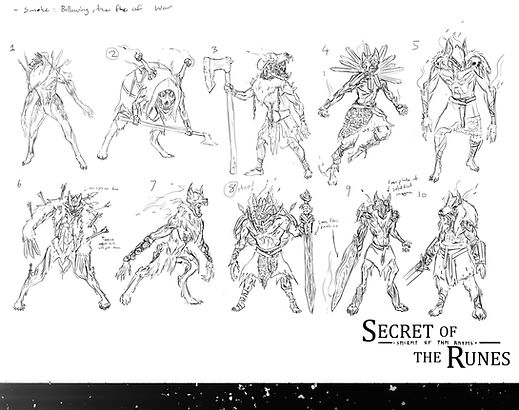
Illustration | Concept Art | Fantasy and Sci Fi Art

"I know that I hung on a windy tree
nine long nights,
wounded with a spear, dedicated to Odin,
myself to myself,
on that tree of which no man knows
from where its roots run.
No bread did they give me nor a drink from a horn,
downwards I peered;
I took up the runes,
screaming I took them,
then I fell back from there."
~ Odin, Rúnatal st. 139 - 146

"How much will you sacrifice?"
Secret of the Runes (SotR) is a hack-n-slash game where the player takes control of a Viking warrior, using his sword and shield to battle monsters in the way of his quest for power.
The main mechanic of SotR is Sacrifice: What is the player willing to give up to further their goals? During combat, the player can sacrifice one aspect of their being, which gives them a myriad of abilities in exchange for a heavy price.
---
SotR is a character design assignment that was completed as part of a character design class in Digipen Institute of Technolgy, during my sophomore year of Spring 2019. The scope of the project was to design four characters - A protagonist (player character), a companion/enemy, a miniboss/second enemy, and a boss within the span of 14 weeks. I expanded my scope to include designs for two enemy types (melee and ranged),and three mini-bosses, along with a character illustration for each character and creature, as well as an in-game mockup image (see above).




Every creative project has key art to set the mood for the product, as well as offer a glimpse into the created "world" of the project. SotR was no different, though the key art was completed months before the start of the bulk of SotR.
Inspired by games such as Hellblade: Senua's Sacrifice and God of War (2018), I sought to capture a sense of oppression and foreboding; such are the emotions one would go through on a journey alone. These pieces of key art are of sections that the player would experience - from ruined monuments of great beings to the rotted evidence of those that went on the same journey before you.

The full lineup of characters designed for SotR: (L to R) Haakon, Draugr, Seidrmann, The Raven, The Wolf, The Serpent, Mimir




"I've given so much, left everyone I loved behind... But for what I seek, I'll sacrifice even my own flesh and blood."
Haakon is a Norseman from the Viking Ages; originally a wealthy thane to a Danish king, he hears about the fabled Well of Mimir and proof of its existence in the real world from a witch, prompting his mad quest to attain its knowledge, as Odin did before. Throughout his life, he has consulted tomes of dark and forbidden knowledge, all in preparation of his journey to the heart of his obsession.
In fact, Haakon has learnt and weaponised certain spells that will aid him in his quest. This is manifested in-game as the Sacrifice mechanic; he gains untold strength and power, although the price he pays ranges from his flesh burning off into a flayed husk, his skull and brain painfully ripping themselves open, to his immortal soul burnt as arcane fuel.
---
Originally, he was made in the mold of a more accurate 12th-century Viking warrior, with full protective armour. As a nobleman, his physique would be smaller than the usual "over muscular brawn" that exemplified the usual Viking design. Even in the ideation stage, I toyed with ideas of how the Sacrifice would manifest, from the face bubbling to limbs warping into wood and bark.
In the end, he had his upper torso stripped, to allow the Sacrifice to be visible and more visceral. His tattoos were a mix of actual Icelandic magical staves (such as the vegvisir and the aegishjalmur), knotwork, and geometric designs dotted with elder Futhark runes.

The finalised sketch of Haakon. Note the patch of chainmail and the tattered cloth around his waist, the worn remains of his once-grand clothing.




"Warriors that went before Haakon, seeking the same treasure. Now they are shambling reminders of what Haakon stands to lose if he fails."
The Draugr are the reanimated bodies of other Norse warriors that went in search of the Well of Mimir before Haakon. Their bodies are twisted and withered, their armour has been worn into tatters and rust, and their weapons are dull and rusted. Despite this, they attack Haakon with all the ferocity they had in life.
---
The Draugr were designed to be both similar (as they are contemporaries of) and different (to facilitate visual recognition) to Haakon. To that end, their physiques showcased more defined muscles, though mixed with their flesh warping into natural forms, like branches, lattices, and the like. It was to be clear that what they had faced in their quest had changed them so terribly that they would not be recognisably human. Their equipment were also rendered with considerably more wear and tear, with holes, rust, and broken sections.


"Practitioners of ancient runic magic, their quest for Mimir's knowledge appears to have been successful... but what they received in return may not have been worth it."
The Seidrmann are shamans that too sought the knowledge of the Well of Mimir, but their journey has physically warped them; their flesh twisting into horrible shapes and their minds utterly broken by what they have witnessed. Something compels them to defend the Well of Mimir, and this compulsion causes them to stand in the way of Haakon and his quest. They wield an array of ruinous spells, no doubt empowered by the dark knowledge that twisted them so.
---
The Seidrmann were designed in conjunction with the Draugr, though since the Seidrmann were magic practitioners, I could be much more imaginative with the state of their bodies. I experimented with much more visible ways of mutation, such as heads being subsumed into fleshy growths, ribs blossoming like flowers, and legs worn down to stumps.
A combined theme the Seidrmann shared with the Draugr is the idea of cranial mutilation, due to the idea of "forbidden knowledge that cannot be contained". While for the Draugr they merely had their mouths sealed with flesh or their skulls cracked open, the Seidrmann received varied designs; their heads warping into tree stumps, exploding into latticed fungi, and melting into their headdresses. The wood theme was also heavier for them, the idea being that the knowledge they received rendered their bodies dead like driftwood.


Since it was decided early on that the creatures could not be the literal embodiment of their animal names, I experimented with forming symbolic representations instead, such as crafting a helmet of wooden planks that form a vague shape of a wolf's head.


"The embodiment of flesh, the Wolf stalks battlefields in search for worthy foes to devour. Some claim it to be Fenrir, son of Loki, and that it is bound by the chains of Gleipnir till the onset of Ragnarok, but the Wolf is unburdened by any bindings.
The question is: Are you willing to sacrifice your flesh to sate the Wolf?"
The Wolf is the mystical embodiment of the aspect of Flesh. A hulking monstrosity of meat, bone, wood, and metal, it wields a broken sword burning with fiery heat, waiting to cleave those that seek to journey to the Well of Mimir.
---
The Wolf is the first of three mini-bosses of SotR, representing the Body in the triad of Body, Mind, and Soul. The overall design was made to resemble a Viking longship, a long body flanked by round shields, the exposed rib bones arranged like the ribs of a ship, and the dragon head at the end of the tail. The fire, solidified lava, and exposed flesh are symbols of the ravaging power the Viking raiders wielded as they raided the coast and cities, while the muscular build of the limbs reinforce the symbolism of the Body, as well as the depiction of physical strength. The head reinforces the design of a longship , and the gold bangles and anklets are a representation of the riches claimed by Viking raids.
Much of the initial design had a more werewolf-like body in mind, to keep it closer to the idea of the Wolf. The pieces of Viking armour and weapons were added to pervert the idea of a warrior; the arms in this case were integrated into the body of the Wolf. In the second round of design, I decided to expand the idea of the perversion of an ideal by increasing the size of the creature to tower over Haakon when it stood, and expanding the motif from a warrior to a longship.




"The embodiment of spirit, the Serpent slinks through the forest, leaving cursed Nithings that sap the strength from people's hearts while strengthening itself. Its claw spews evil magic that slowly kill those it touches.
The question is: Are you willing to sacrifice your soul to quench the Serpent?"
The Serpent is the embodiment of the Soul. A creature made of wood, flesh, and bone, it uses a serpentine maw mounted on the end of a twisted rope of sinew and vine to cast spells that burn the flesh of those that enter its domain.
---
The Serpent is the second of three mini-bosses of SotR, representing the Soul in the triad of Body, Mind, and Soul. The Serpent is loosely based on shamans and Celtic Druids, with more emphasis on the serpent motif, and natural materials like wood and vines. The Serpent also makes use of the tree as a motif; a central body with many limbs radiating out.
Much of the initial design was focused on designing a serpent without resorting to a lamia-esque design or a giant snake. The serpent idea was more fully integrated by having it as a limb, or the monster having two tails like a melusine. The woodwork also served to link the Serpent to the Seidrmann, as both are magic users. The helix formed of the flesh twisting with the vines is a visual shorthand for the soul being intertwined with the body, while forming a more interesting and complex shape than a mere cylinder.
The Nithing poles were added as a gameplay element, the idea being that the Serpent would be invulnerable unless the Nithing poles were destroyed. They was a simplification of the Serpent's torso, sharing much of the same motifs, though the head mounted on the pole is a horse skull, as it historically was the head used on actual Nithing poles.




"The embodiment of thought and memory, the Raven wanders the shores, watching the skeletons of beached longships, and surveying the memories that wash up on the waves. Some it takes from the waters, and yet most it leaves; walking away before the waves take the object away. In combat it relies on subterfuge, vanishing into inky smoke before appearing somewhere else to strike unseen.
The question is: Are you willing to sacrifice your mind to understand the Raven?"
The Raven is the mystical embodiment of the aspect of the Mind. A tall, reedy being, it uses its wings to create giant gusts of smoke that blind its opponents, allowing it to swoop from another angle with the element of surprise.
---
The Raven is the third of three mini-bosses of SotR, representing the mind in the triad of Body, Mind, and Soul. Though also based on shamans as the Serpent was, the Raven leans more towards the idea of the shaman of a "learned man", with a crown formed of a raven's skull, with a mantle made of a nest-like arrangement of bones.
For the initial design of the Raven, I toyed with the idea of representing the wings of the Raven figuratively, to minimize the requirement of having to draw so many feathered wings. Most of the wing designs were elongated arms with tattered cloth strips, or flaps of tattered cloths. The head design was also designed to be vastly different to a raven's head, from a crown formed of raven skulls pointing upwards, to a collection of bones tied together into a nest-like form.
In the end, the designs were too far removed from the idea of the Raven that I chose to move it closer to the initial animal, though I decided to add the flayed back in the manner of a "blood eagle" to symbolise the origin of its wings and to tie the mutilated designs of all the antagonist designs together.





"Aha, so here you are. You've faced your demons, made your sacrifice, and journeyed all the way to the base of Yggdrasil, where Odin left me with the Well. Just like so many others, you sought the waters of this well and the knowledge held within. You don't know of the price you must pay to even have a sip.
Very well; prove to me that you're worthy of even stepping into the presence of the Well!"
Mimir is the Aesir God of knowledge and wisdom. Beheaded by the Vanir for an act of deceit he did not commit, Odin brought Mimir's head back to life to ensure his counsel lives on forever, leaving him at the Well of Mimir to safeguard its knowledge.
---
Mimir, though based on the Norse god of the same name, could not be recognisably human since he had to fit the design of the other enemies Haakon faces in SotR. To that end, his head has its skin removed and the brain expanded to encompass the top of his head, to exemplify the significance of the brain of a god of wisdom and to imply that Odin's methods of preservation were not as painless or foolproof as it was believed. In combat, Mimir controls a giant "war-form" forged from the remains of various creatures and warriors of ages past, using a fleshy battering ram arm and powerful magic to defend the Well of Mimir.
Mimir's head was designed first, as it was a distinct part of him separate from the body, and would influence the design of his "war-form" body. The design focused on the rough method of Odin's ritual to preserve Mimir, with flesh and bone warping and runes carved into the head itself.
The body was designed to be much more monstrous than a human body, as Mimir would see fit to design a body that would have combat effectiveness that would surpass a regular human's body. Flesh and bone are also exposed, since Mimir would have put the body together from pieces of flesh, rather than combine them into a perfected body, owing to the fact that he has been reduced to merely a head.

